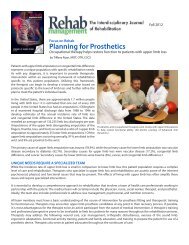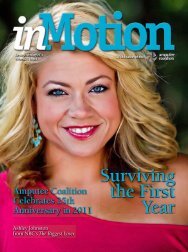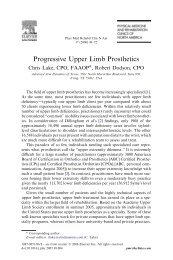After amputations, Cedar Mill Elementary teacher finds learning ...
After amputations, Cedar Mill Elementary teacher finds learning ...
After amputations, Cedar Mill Elementary teacher finds learning ...
Create successful ePaper yourself
Turn your PDF publications into a flip-book with our unique Google optimized e-Paper software.
When she returned, she sat down and talked to the kids about her new hand and legs. She showed them pictures of<br />
animals with prosthetic limbs, including an elephant.<br />
She allowed the students to try out her electric hand. The boys, as expected, wanted one of their own.<br />
“It didn’t really matter what she looked like,” said Ella DeVeaux, 8. “She’s nice on the inside.”<br />
Whitehead always warns the kids before taking off the hand, which extends up her forearm. What remains is not<br />
scarred or ugly. It’s simply her forearm, smooth skinned and rounded.<br />
“It was a little scary, but then I got used to it,” said Eva Muir, 9.<br />
Whitehead is proud of the students.<br />
“They’re so accepting of the whole thing,” she said. “I’m real open about the frustrations. They’re like family, they just<br />
kind of watch me.”<br />
She’s made an impression on them as well, especially the older kids.<br />
“I don’t think I would come back because I would be embarrassed,” said Schuyler Dull, 11. “Mrs. Whitehead has inspired<br />
me.”<br />
Whitehead, who is married and has two grown sons, has taught at <strong>Cedar</strong> <strong>Mill</strong> for 12 years and is a popular instructor.<br />
She teaches art part-time, which was her job before the <strong>amputations</strong>.<br />
“She provides a wonderful model of endurance, fighting spirit and grit,” <strong>Cedar</strong> <strong>Mill</strong> Principal Brian Horne said in an<br />
email.<br />
As winter break approached, Whitehead worked with students on sculpting clay, but she also teaches them drawing,<br />
collage, stitching, papier-mâché and acrylic painting. She has found ways to demonstrate the artwork she wants the<br />
students to create.<br />
Her prosthetic specialist MacJulian Lang, of Advanced Arm Dynamics in Tigard, said it helps that doctors were able to<br />
save most of her right hand. “She needs at least one side with intact sensation and finer use than the prosthetic,” he<br />
said.<br />
The prosthetic hand is electric, and sensors at the top of the device read the electrical activity when she contracts<br />
muscles in her arm. Whitehead must think about opening or closing her hand, bending it up or down and the sensors<br />
read the muscles and perform the activity with the hand.<br />
“She can vary the speed of the hand by how strong she makes a muscle,” Lang said.<br />
Whitehead said her legs are more difficult to use than the arm.<br />
“It’s like walking on stilts,” she said. Stairs and slopes are especially difficult because there is little flex in the ankles.<br />
“She is a role model,” said Kathy Smyth, fourth-grade <strong>teacher</strong>. “The minute we get the urge to grinch about something,<br />
we think of her. She is incredible.”<br />
Whitehead’s desire to continue teaching played a big part in her determination to return to a regular life. “The role in<br />
my recovery was huge,” she said, of teaching. “There have been times when I didn’t think I could do it.”<br />
But, she added, “I’m a pretty stubborn person, and that works in my favor.”










